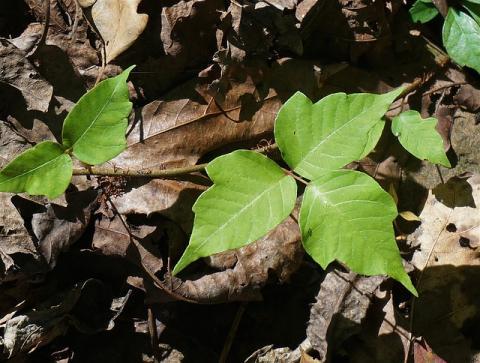
As spring really start to takes off – and then all of a sudden becomes full-fledged summer! – it can be all too tempting to frolic bare-legged amidst all the greenery. But be on guard; amidst all the lovely-smelling foliage emerging also hide some poisonous plants that you don’t want to stick your nose in…or any part of your body, for that matter. In addition to watching out for poisonous plants in your backyard garden, watch out for the wild-roaming poisonous plants, too.
Poison ivy, poison oak and poison sumac all contain the same toxin, urushiol oil, which is present in all parts of the plant. Even dead poison ivy, oak and sumac plants can still contain the toxic oils, and the irritating oils can also stay on clothing or animals that have come in contact with the plants. The itchy, sometimes blistering rash that results from making contact with these common summertime plants is sure to put a damper on summer fun, so know how to identify and avoid these three unassuming and toxic plants.
For poison ivy and poison oak, always remember: “Leaves of three, let it be.”
For poison sumac, you simply need to know how to identify it.
Common (Eastern) and Western Poison Ivy (Toxicodendron radicans and Toxicodendron rydbergii)
Common in: Most of the U.S., especially in the Great Lakes region and Northeast, and excluding Alaska, Hawaii and parts of California and the south.
Spot it: In fields, wooded areas, on roadsides, along streams or disturbed areas…and even in backyards, parks, or just off the local soccer field.
Identify it: On the west coast, poison ivy is commonly more of a low-lying shrub, whereas on the east coast and in the Midwest, it tends to grow as a climbing vine. Shiny, slightly jagged-toothed leaves grow in clusters of 3 and are light greenish in color, but often change to be yellowish red in the fall. Greenish-yellow or amber colored berries grow at the base of the foliage.
Eastern and Western Poison Oak (Toxicodendron pubescens and Toxicodendron diversilobum)
Common in: West coast, eastern and southern U.S.
Spot it: In the same places as poison ivy.
Identify it: Like poison ivy, poison oak is usually a small shrub, but can grow into a vine. As its name suggests, the leaves resemble the form of an oak leaf, with more teeth than the leaves of poison ivy. This characteristic makes it easy for poison oak to blend in with the plants around it, as well. Its leaves also grow in clusters of 3, but also in groups of 5 or 7, and are light greenish in color, changing color to reddish-orange with the surrounding plants in the fall. Yellowish-white berries grow in clusters at the base of the foliage.
Poison Sumac (Toxicodendron vernix)
Common in: The Midwest, all over the northeast, and in parts of the southeast.
Spot it: Almost exclusively in wet areas like bogs, marshes, swamps, or riverbanks.
Identify it: Unlike poison ivy or poison oak, poison sumac grows as a tall shrub or small tree with fan-like leaves growing 7-13 on a reddish stem. The leaves are oval to a point, and also change color with the seasons. Glossy pale yellow or cream-colored berries grow off an independent stem.
Above all, take precautions when you think you (or someone else) may be near poison ivy, oak, or sumac:
- Avoid touching any parts of the plants, whether dead or alive.
- Avoid touching animals or pets that may have made contact with the plants.
- Avoid burning the plants (or areas that may contain the plants) because the oils can also be inhaled on the smoke of the burning plants.
AND, if you believe you may have made contact with the plants:
- Wash all clothing separately, whether or not it made direct contact with the plants.
- Removing the oils with one of the methods listed below within 10 minutes of making contact can decrease the likelihood of a rash forming – so, when in doubt, wash it off!
- Rashes can take between 24 hours to 72 hours to emerge, and may last up to three weeks depending on severity
- Rashes are not contagiously spread to others or to other parts of the body by puss leaking from blisters.
Depending on what you need to remedy regarding contact with any of these three plants, use one or some of these natural, “cupboard” remedies for oil removal and itch relief/soothing.
To remove oils (within 10 minutes of making contact) gently dab, not rub, with a clean cloth on area of contact:
- Rubbing alcohol
- Apple cider vinegar
- Lemon juice
- Himalayan sea salt paste (a mixture of sea salt and water)
To soothe the itch (temporarily) place on the affected area:
- Cucumber (either slices or mashed into a paste)
- The inside of a banana peel
- The inside of watermelon rind
- Aloe vera (best if it’s an actual clipping from a plant!)
- Organic witch hazel on a clean cloth
To relieve the itch/avoid scratching/cool the burning sensation:
- Cool compresses with water and/or milk
- Oatmeal bath (1 cup of ground oats in the bathtub) or paste (mixed with water)
- Baking soda bath (1 cup of baking soda in the bathtub) or paste (mixed with water)
- Organic goldenseal paste or poultice
NOTE: If the poison ivy/oak/sumac rash is very widespread, in an orifice (eyes, nose, mouth, genitals), or has been inhaled by way of smoke, it’s best to visit your doctor for treatments alternative to natural remedies. For some people, contact with any of these plants can cause a severe allergic reaction or anaphylactic shock. Some people also don’t react at all.








